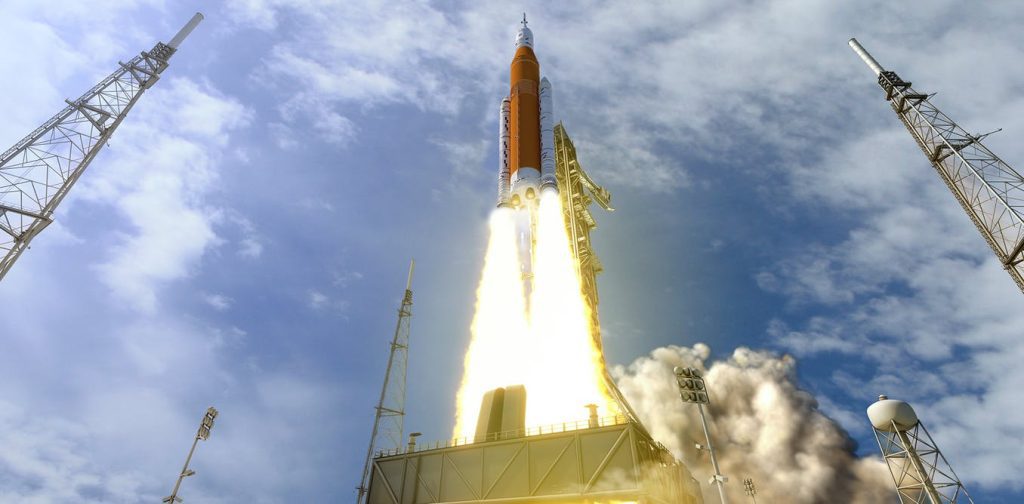The year 2022 should mark an important step in the return to the Moon. Indeed, in a few months the first mission of the American new moon program, Artemis, should take off. What will be the process, and what will be the technical and economic challenges of this huge space project that will extend for a whole decade?
Announced at the end of August at the earliest, the Artemis I mission will see the first launch of NASA’s new giant launch vehicle, the SLS (space launch system). Originally scheduled for the end of 2016, the program is experiencing significant delays. Last April again, was the last major test before launch, which is wet rehearsal, revealed many technical problems, especially with regard to filling tanks with liquid oxygen and hydrogen. So NASA had to return the launcher to its assembly building for repair. A new trial is scheduled for June 20, 2022 On Launch Pad 39B at Kennedy Space Center, Florida.
Once this test is validated, the Artemis I mission can be performed. It must be said that the SLS is a particularly complex technical object. At 70 tons and nearly 100 meters tall, it would be the most powerful launcher ever built, surpassing the iconic Saturn V rocket that carried 24 American astronauts to the moon between 1968 and 1972.
Three steps back to the moon
At the top of the SLS is the Orion spacecraft, on which the astronauts will travel. Orion uses its older brother’s geometry, the Apollo module, but with larger dimensions. Thus, four astronauts will be able to make a trip to the Moon during each mission, compared to three astronauts at the time of Apollo.
NASA
But initially, the SLS will launch an empty Orion ship to test all phases of the mission. It will remain in lunar orbit for several days to allow NASA engineers to check its performance. Thanks to the engines of the service module created by the European Space Agency, it will then return to Earth, in order to test the critical stages of re-entry into the atmosphere and landing.
If the rehearsal is successful, it will follow the first manned flight during the Artemis II mission, currently scheduled for mid-2024. Like their Apollo 8 predecessors, the mission’s four astronauts will fly over the moon but not land on it. So we will have to wait for Artemis III to see the real return of the crew to the surface of our satellite. After leaving Orion to land on HLS (human landing system), two astronauts, including the first woman to walk on the Moon, will spend nearly a week on the surface, more than double the record set during the Apollo missions. However, the mission, scheduled for 2025, may face several years of delay According to the latest report by the Inspector General of NASA.
In parallel, a space station, Gateway, will be assembled in lunar orbit from the end of 2024. It is much smaller than the International Space Station (ISS), and will be based on a similar partnership between the American and European space agencies, Japanese and Canadian, but this time without Russia. In the end, At least three European astronauts And therefore must remain on board this station in the lunar orbit that One of the units is already under construction in France.
stay long term
The portal is one of the big differences between the Artemis and Apollo programs. By providing a transit point and place for experience between the Earth and the Moon, it is presented as a component of sustaining a return to the Moon. Because NASA realized that there is a file A strong challenge to overcome the symbolic and accurate return On the moon, having won the race more than fifty years ago. As American astrophysicist John Horak pointed out in 2019The motives for returning to the Moon today are less geopolitical than economic. Artemis conventions, which France has just joinedfor example expressly states the possibility ofExtracting resources from the moondespite the feasibility of associated business models Still far from visible.
Read more:
Who owns Mars and the Moon and their natural resources?
The US space agency is also encouraging the creation of a commercial ecosystem around the moon. In a program Commercial Lunar Payload Services (CLPS), private actors are funded to build ships capable of landing on the Moon and deposit tools or robots there, which can also be developed by private companies. Lunar landers from Intuitive Machines and Astrobotic Technology will be the first to attempt maneuvering, in principle, by the end of 2022.
By the same logic, HLS that will deposit astronauts on the Moon has also been subcontracted with a special partner, SpaceX. Elon Musk is not just a service provider and develops its own projects in parallel. For example, it announced that it had sold a ticket to Japanese billionaire Yusaku Maezawa for a tourist trip in orbit around the moon, Simpler and cheaper than landing on the moon. Originally announced for next year, deadlines are unlikely to be met due to Recent disappointments faced by SpaceX in developing the new Starship launcher.
New international momentum
Long-term stability is also the challenge for the only other two space powers to have successfully landed on the Moon: Russia and China. If Russia has been a historical player in the race for the moon, like the United States, China has caught up significantly by introducing it for the first time. Landing craft on the far side of the moon in 2019performed successfully Moon rocks return to Earth in 2020.
Read more:
Objectif Lune: Time to redeem?
In 2021, China and Russia announced their willingness to join efforts to build an orbital stationInternational Lunar Research Station (ILRS), scheduled for early 2030. Until then, several robotic missions were planned, including Chang’e 6 on the Chinese side and Luna 25 on the Russian side. The name of this last mission, Planned for this fallis a continuation of the Soviet Luna program, of which Luna 24 was the last representative since 1976. Other countries, India, South Korea, United Arab Emirates and JapanThey are also planning missions to the Moon in the coming months.
In the long run, the idea behind Artemis is to Reusing advances made on the maiden voyage to Mars by 2040. However, it must be remembered that the challenges posed by a manned flight to Mars do not match those of the Artemis program which, although The cost of NASA is approaching $100 billion, is still far from allowing a permanent installation on the Moon. Making our satellite a destination in itself is the challenge space players will have to face long before they ever hope to reach the Red Planet.

“Hardcore beer fanatic. Falls down a lot. Professional coffee fan. Music ninja.”







More Stories
Video game enthusiasts help demystify the gut microbiome
NASA's Mars helicopter sends its final message
Homer Simpson's “donut craze” spreads to Montreal